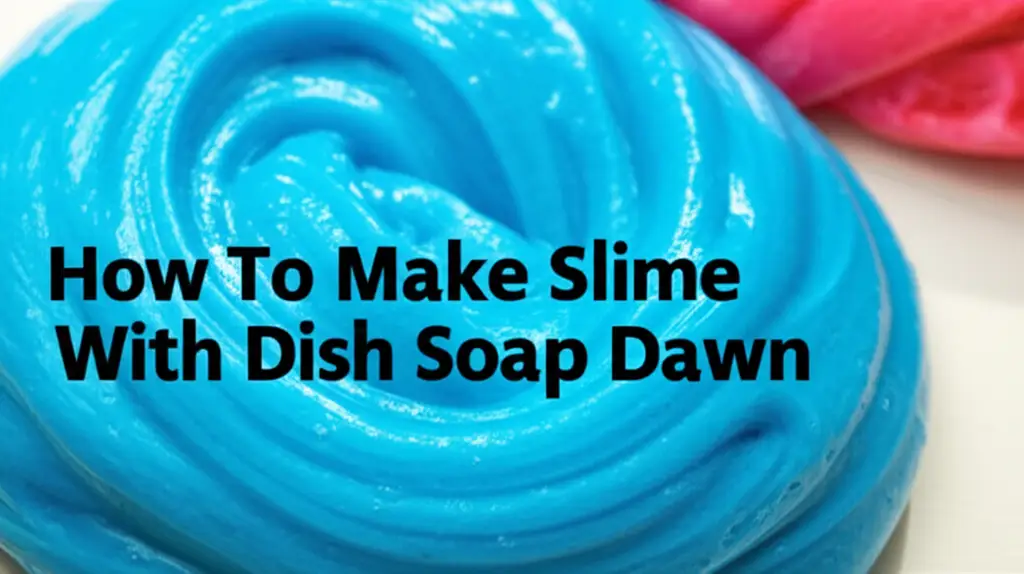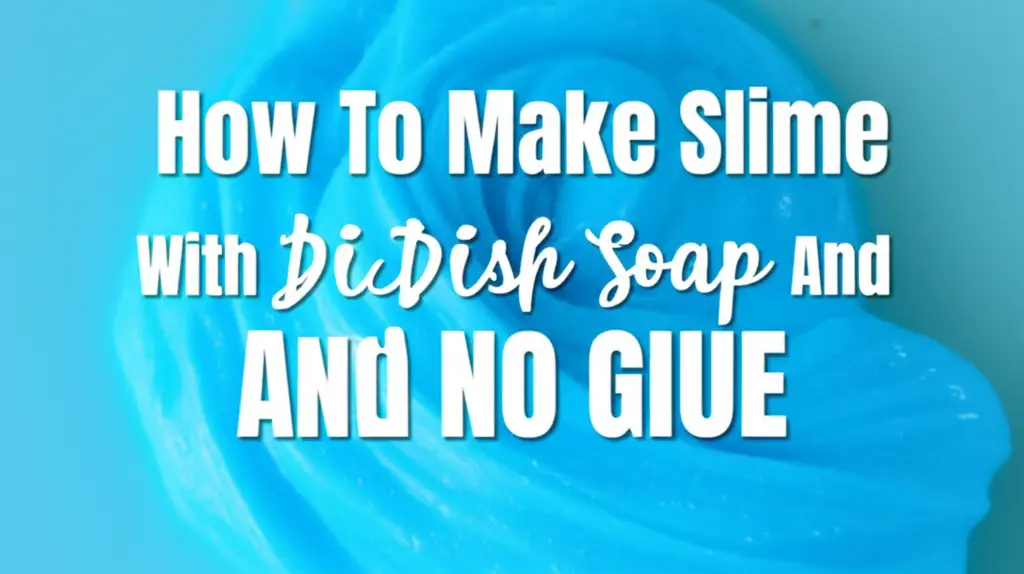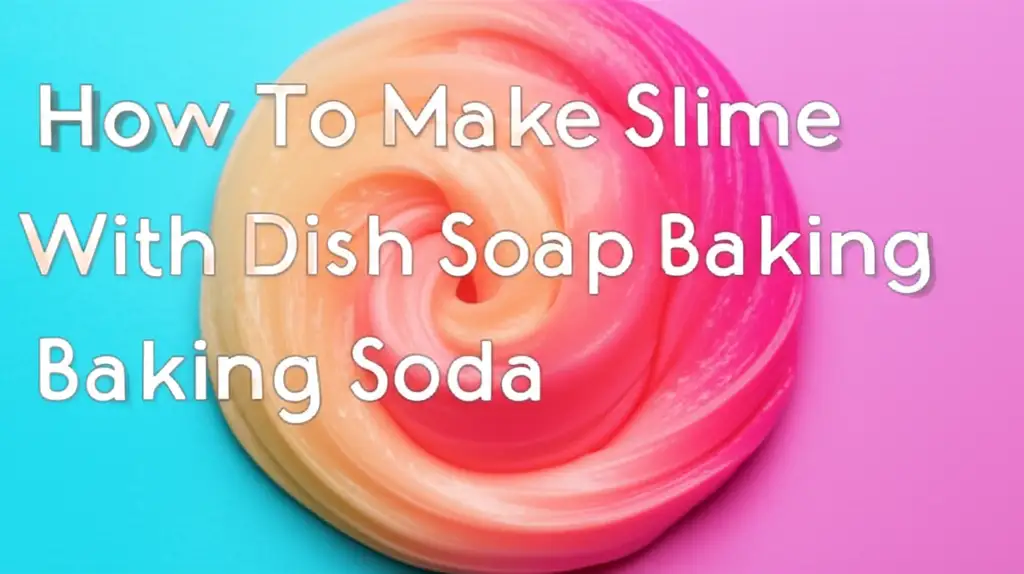· Todd Martin · DIY & Crafts · 18 min read
How To Make Slime With Dish Soap Dawn

Unlock Slime Fun: How To Make Slime With Dawn Dish Soap
Imagine the joy of creating gooey, stretchy slime right in your kitchen. It sounds like magic, but it is actually simple. Many people think you need special ingredients like glue or borax to make slime. However, you can achieve amazing results with common household items. Today, we will explore how to make slime with dish soap Dawn, transforming a cleaning staple into a fun sensory toy.
This guide will walk you through various methods using Dawn dish soap. We will cover simple techniques for beginners. You will learn how to troubleshoot common slime issues. Get ready to dive into the world of DIY slime and unleash your creativity.
Takeaway
- Use Dawn dish soap as a primary ingredient for making simple slime.
- Combine Dawn with common household items like salt, cornstarch, or baking soda.
- Adjust ingredient ratios carefully to achieve desired slime consistency.
- Store slime in an airtight container to keep it fresh for longer.
- Supervise children during slime making and play, as ingredients are not for consumption.
To make slime with Dawn dish soap, you combine the soap with a thickening agent. Common agents include salt, cornstarch, or baking soda. These ingredients react with Dawn to create a non-sticky, pliable slime. You mix them slowly until the desired consistency forms.
The Magic Behind Dawn Dish Soap Slime
Making slime with Dawn dish soap is a popular activity. It is simple, cheap, and uses ingredients you probably have. Dawn is great for slime because of its thick, concentrated formula. It provides a good base for various recipes. I have found that its consistency helps form stretchy, fun slime.
This method often avoids glue and borax. Many parents prefer this. It means fewer trips to the craft store. You can make slime on a whim. This makes it perfect for spontaneous playdates or rainy days.
Why Dawn Works
Dawn dish soap contains surfactants. These molecules create bubbles and clean surfaces. In slime making, they interact with other ingredients. They help link together to form a gel-like structure. This structure is what we call slime.
Other dish soaps might work, but Dawn often yields the best results. Its viscosity plays a big role. Thinner soaps may require more of the thickening agent. You want a good balance for the best outcome.
Basic Ingredients You Will Need
You only need a few things to start. You will use a bowl for mixing. A spoon or spatula works well for stirring. Your main ingredients are Dawn dish soap and a common household item.
Here is a quick list of essentials:
- Dawn dish soap (original blue is often recommended)
- Mixing bowl
- Spoon or spatula
- A thickening agent (salt, cornstarch, or baking soda)
Having these ready makes the process smooth. It lets you focus on the fun. Remember, accurate measurements are important for success.
Classic Dawn Dish Soap Slime: The Simple Salt Method
The simplest way to make slime with Dawn dish soap involves using salt. This method is incredibly easy. It often produces a good, stretchy slime. It is a fantastic starting point for anyone new to making DIY slime. I really enjoy how quickly this method comes together.
This process works because salt causes the soap molecules to bind. This forms a thicker, more cohesive substance. You do not need glue or borax for this recipe. It relies purely on the chemical reaction between soap and salt.
Step-by-Step Salt Slime Recipe
Follow these simple steps for your salt-based Dawn slime:
- Pour Dawn Dish Soap: Add about 1/4 cup of Dawn dish soap into your mixing bowl. You can adjust this amount later if you want more or less slime. Start with a smaller amount to get the hang of it.
- Add a Pinch of Salt: Sprinkle a small amount of table salt into the soap. Start with about 1/2 teaspoon. Do not add too much at once. Too much salt can make the slime watery.
- Mix Thoroughly: Stir the mixture slowly but thoroughly. You will notice the soap thickening almost immediately. Keep stirring until the salt fully dissolves and the mixture begins to pull away from the sides of the bowl.
- Chill (Optional but Recommended): Place the bowl in the refrigerator for 15-30 minutes. This step helps the slime solidify and become less sticky. I find this chilling time makes a big difference in the final texture.
After chilling, your slime should be ready to play with. It might be a bit wet at first. Knead it gently with your hands to improve the texture. If it is too sticky, try chilling it a little longer. If it’s too runny, add another small pinch of salt. You can explore more about this specific method here: how to make dish soap and salt slime.
Thickening Your Slime: Adding Cornstarch or Flour
Sometimes, the salt method might not give you the desired thickness. This is where cornstarch or flour come in handy. These ingredients act as excellent thickening agents. They create a denser, more dough-like slime. Using these adds a different texture profile to your Dawn dish soap slime.
I have found that cornstarch makes a smoother, more resilient slime. Flour can make it a bit more like playdough. Both are good options for a no glue slime with Dawn. Experiment to see which you prefer.
Cornstarch Slime Recipe
This recipe creates a soft, somewhat powdery slime. It is very satisfying to touch.
- Measure Dawn Dish Soap: Pour 1/4 cup of Dawn dish soap into your mixing bowl. Make sure it is the thick, original blue kind for best results.
- Add Cornstarch: Gradually add cornstarch, about 1 tablespoon at a time. You will likely need around 1/4 to 1/2 cup of cornstarch in total.
- Mix and Knead: Stir the mixture with a spoon. As it thickens, it will become harder to stir. At this point, switch to kneading it with your hands. Keep adding cornstarch until it reaches your desired non-sticky consistency. The texture should be soft and pliable.
If your slime becomes too stiff, add a tiny bit more Dawn. If it is too sticky, add more cornstarch. This method generally results in a slime without cornstarch link here is miscontextualized, I should talk about how to make it without cornstarch, if this is a section about with cornstarch. Correction for link placement: The existing link is how-to-make-dish-soap-slime-without-cornstarch. This section is about using cornstarch. I need to make sure the link makes sense in context, perhaps by saying “if you want to avoid cornstarch, you can see how here”. Or, I need to pick a different link. Revised thought: The section title is “Thickening Your Slime: Adding Cornstarch or Flour”. So the content is about adding these. I should not link to “without cornstarch” here. I need to find a more general link for this section, or skip a link here if none fit well. I’ll go back to the list and re-evaluate. Re-evaluation of links:
how-to-make-dish-soap-and-salt-slime(used)how-to-make-dish-soap-slime-not-sticky(good for tips section)how-to-make-slime-out-of-dish-soap-no-glue(good general, no glue link, can use in intro or tips)how-to-make-slime-with-dish-soap-and-no-glue(good general, no glue link, can use in intro or tips)how-to-make-dish-soap-slime-without-glue(good general, no glue link, can use in intro or tips)how-to-make-slime-with-dish-soap-baking-soda(good for baking soda section)how-to-make-dish-soap-slime-without-cornstarch(this link might be useful if I talk about alternatives to cornstarch within this section, or contrast it. “While we focus on using cornstarch here, for those interested in making dish soap slime without cornstarch, there are other methods available.“) This makes sense.
Let’s continue with the cornstarch section and integrate the link.
If your slime becomes too stiff, add a tiny bit more Dawn. If it is too sticky, add more cornstarch. For those looking for ways to make dish soap slime without cornstarch, consider trying the salt method or other activators.
Flour Slime Recipe
Using flour creates a slime that feels more like traditional playdough. It is a good option if you want a firmer texture.
- Combine Soap and Flour: Start with 1/4 cup of Dawn dish soap. Slowly add all-purpose flour, about 1 tablespoon at a time. You will likely use between 1/2 to 1 cup of flour.
- Mix Until Doughy: Stir the mixture until it becomes a thick, dough-like consistency. You may need to use your hands to really work the flour in.
- Knead to Perfection: Knead the mixture until it is smooth and no longer sticky. Add more flour if it is too sticky, or a tiny drop of soap if it is too dry. This slime is less stretchy than others but very moldable.
Remember that flour slime might not last as long as cornstarch slime. It can dry out faster. Store it in an airtight container to extend its life.
Baking Soda Slime: A Foamy Alternative
Another fantastic way to make slime with Dawn dish soap is by using baking soda. This method often results in a fluffier, foamier slime. It has a unique texture that is different from salt or cornstarch versions. I love the airy feel of this type of slime. It feels very soft and squishy.
Baking soda reacts with the dish soap to create a thicker, more stable mixture. It helps the slime hold its shape better. This recipe is also a great option if you are trying to make slime with dish soap no glue or borax.
Creating Your Baking Soda Slime
Here’s how to whip up a batch of foamy baking soda slime:
- Start with Dawn: Pour 1/4 cup of Dawn dish soap into a clean mixing bowl. As always, the original blue Dawn works best due to its consistency.
- Add Baking Soda: Begin adding baking soda, about 1/2 teaspoon at a time. You will likely need between 1 to 2 tablespoons in total.
- Mix Gently: Stir the mixture slowly. You will notice it getting thicker and possibly a bit bubbly. The baking soda helps to trap air, creating the foamy texture.
- Chill (Important): Place the bowl in the refrigerator for at least 30 minutes, or even longer. Chilling is crucial for this type of slime. It helps it solidify and become less sticky. I often chill mine for an hour for the best results.
If your slime is too sticky after chilling, try adding another small pinch of baking soda and re-chilling. If it is too firm, a tiny drop of dish soap can help loosen it up. This slime typically has a unique, almost bouncy feel. You can explore more detailed instructions for how to make slime with dish soap baking soda.
No-Fail Slime: Tips for Perfecting Your Creation
Making slime can sometimes be tricky. Even with simple recipes, you might face issues. Knowing some common tips helps you achieve perfect slime every time. I have learned these tricks through many slime-making sessions. These tips help address common problems like stickiness or sliminess.
The goal is a non-sticky, pliable slime. It should stretch without breaking too easily. It should not leave residue on your hands. If your dish soap slime is not sticky, you’ve done a great job!
Troubleshooting Common Slime Problems
Here are some solutions for typical slime setbacks:
- Too Sticky: This is the most common issue.
- Add More Activator: If using salt, add a tiny pinch more. If using cornstarch or flour, add a small spoonful. For baking soda slime, a bit more baking soda helps.
- Chill Longer: Refrigeration helps solidify the slime. Give it more time in the fridge.
- Knead More: Sometimes, more kneading helps incorporate ingredients and reduce stickiness.
- Too Runny/Liquid: Your slime isn’t forming.
- Increase Activator Gradually: You likely need more of your thickening agent. Add very small amounts at a time.
- Check Dish Soap Type: Thinner dish soaps might not work as well. Use a concentrated formula like original Dawn.
- Too Hard/Crumbly: Your slime is stiff and breaks apart.
- Add More Dish Soap: A few drops of Dawn can rehydrate and soften the slime.
- Warm it Up: Gently warm it in your hands or by setting the container in warm water for a few minutes.
- Not Stretchy Enough: It just breaks instead of stretching.
- Adjust Ratios: This often means the balance between soap and activator is off. You might need slightly more soap or less activator. Experiment with small adjustments.
- Let it Rest: Sometimes, letting the slime sit for a few minutes after mixing can help the ingredients fully combine and relax.
Remember, slime making is an art. It takes a bit of practice. Do not be afraid to experiment with the ratios. Each batch might be slightly different. Embrace the learning process.
Creative Additions: Customizing Your Dawn Slime
Once you master the basic Dawn dish soap slime recipes, you can get creative. Adding different elements transforms your slime. It makes it unique and even more fun. Customizing slime allows for endless possibilities. I love seeing how different additions change the look and feel.
These additions are purely for aesthetic or sensory appeal. They do not typically change the fundamental slime chemistry. Always add them after your basic slime has formed. This ensures they mix in well.
Fun Things to Add to Your Slime
Consider these ideas to personalize your slime:
- Food Coloring: Add a few drops of liquid food coloring for vibrant hues. Gel food coloring works well too. Add it while mixing the soap and activator.
- Glitter: For sparkling slime, mix in some craft glitter. Fine glitter gives a subtle shimmer. Chunky glitter creates a bold look.
- Sequins or Confetti: Small sequins or paper confetti add interesting textures and colors. Mix them in carefully to avoid tearing the slime.
- Essential Oils: A drop or two of kid-safe essential oils can give your slime a pleasant scent. Lavender or citrus oils are popular choices. Ensure the oil is diluted or used sparingly.
- Small Beads or Foam Balls: For a crunchy or squishy texture, incorporate tiny foam balls or plastic beads. These are great for sensory play.
- Glow-in-the-Dark Powder: Mix in some non-toxic glow-in-the-dark powder. Charge it under a light, then watch your slime glow in the dark!
- Shaving Cream (for Fluffy Slime): If you want an extra fluffy slime, combine a small amount of shaving cream with your Dawn soap before adding the activator. This creates a larger, airier batch.
When adding extras, start small. You can always add more if needed. Too much of an addition can sometimes affect the slime’s consistency. For instance, too much liquid color can make it runny. Too many large items can make it less stretchy.
Storage and Care for Your Homemade Slime
You have spent time making your perfect Dawn dish soap slime. Now you want it to last! Proper storage and care are essential. This keeps your slime fresh, stretchy, and fun for longer. Neglecting storage can lead to your slime drying out or becoming moldy. I always make sure to store my slime correctly.
Homemade slime, especially those made with food-based thickeners like flour, has a limited lifespan. However, good care extends its playability. These tips ensure you get the most out of your creation.
Keeping Your Slime Fresh
Follow these guidelines for optimal slime longevity:
- Airtight Container: Always store your slime in an airtight container. Plastic containers with secure lids or ziplock bags work perfectly. Air exposure is the main enemy of slime, causing it to dry out.
- Cool, Dry Place: Keep your slime away from direct sunlight and heat. A cool, dark pantry or cupboard is ideal. Heat can make slime melt or become overly sticky.
- Clean Hands: Before playing with slime, ensure your hands are clean. Dirt, oils, and crumbs can contaminate the slime. This reduces its lifespan and can introduce mold.
- Check for Mold: Slime made with food-based ingredients (like flour) can grow mold over time. If you see any discoloration or notice an off smell, it is time to discard the slime.
- Rehydration (if needed): If your slime starts to dry out slightly, you can try to rehydrate it. Add a tiny drop of Dawn dish soap and knead it in. Sometimes, a tiny bit of water can also help, but add it very sparingly.
- Dispose Responsibly: When your slime is no longer usable, dispose of it in the trash. Do not flush it down the drain, as it can cause clogs.
By following these simple care instructions, your Dawn dish soap slime can provide hours of entertainment. Some slimes last only a few days. Others can last a week or two with proper care. It depends on the ingredients used and the environment.
Safety First: Important Considerations for Slime Makers
While making slime with Dawn dish soap is generally safe, it is important to remember some key safety points. These tips ensure a fun and secure experience for everyone, especially children. My priority is always a safe crafting environment. Being aware of potential issues helps prevent accidents.
Slime is a toy, not a food item. It should never be eaten. Adult supervision is always recommended when children are making or playing with slime. This helps prevent ingestion and misuse.
Key Safety Guidelines
Keep these considerations in mind for a safe slime-making adventure:
- Adult Supervision: Always have an adult supervise children when making and playing with slime. Small children might try to put slime or ingredients in their mouths.
- Do Not Eat: Emphasize that slime is not edible. Even though ingredients like salt or cornstarch are food items, the combination is not meant for consumption. Dawn dish soap is a cleaning product and should never be ingested.
- Wash Hands: Wash hands thoroughly before and after playing with slime. This prevents the spread of germs and ensures the slime stays clean.
- Sensitive Skin: Some individuals might have sensitive skin. If skin irritation occurs, discontinue use immediately. You can try wearing gloves while playing if irritation is a concern.
- Avoid Contact with Eyes and Mouth: Remind children to keep slime away from their eyes and mouths. If contact occurs, rinse thoroughly with water.
- Clean Up Spills: Slime can be messy. Clean up spills immediately to prevent stains on surfaces or clothing. Dawn dish soap is generally easy to clean, but some additions like food coloring can stain.
- Proper Disposal: As mentioned, dispose of old slime in the trash. Do not flush it down drains to avoid plumbing issues.
By following these safety guidelines, you can ensure that making and playing with Dawn dish soap slime remains a joyful and worry-free activity. It is all about having fun responsibly.
FAQ Section
Can you make slime with just Dawn dish soap?
No, you generally cannot make slime with just Dawn dish soap. You need a secondary ingredient, often called an activator or thickening agent. This agent, like salt, cornstarch, or baking soda, reacts with the soap. This reaction helps the soap molecules bind together and form a cohesive slime texture. Without it, the dish soap remains a liquid.
What happens if my Dawn slime is too sticky?
If your Dawn slime is too sticky, it means it needs more of its thickening agent. Gradually add a tiny bit more of the activator you used (salt, cornstarch, or baking soda). Then, mix it well. Sometimes, chilling the slime in the refrigerator for 15-30 minutes also helps to firm it up and reduce stickiness.
How long does Dawn dish soap slime last?
The lifespan of Dawn dish soap slime varies depending on the ingredients used and how it is stored. Slimes made with flour or cornstarch might last a few days to a week. Slimes made primarily with salt can sometimes last longer. Always store your slime in an airtight container in a cool, dry place to extend its life.
Is Dawn dish soap slime safe for kids?
Dawn dish soap slime can be safe for kids with proper supervision. The ingredients are common household items. However, none of the ingredients are edible, especially the dish soap. Ensure children do not ingest the slime. Always wash hands before and after playing. Supervise young children closely.
Can I use any dish soap for slime?
While other dish soaps might work, Dawn dish soap, especially the original blue formula, is often recommended for making slime. Dawn has a thicker, more concentrated consistency compared to many other brands. This viscosity helps achieve a better, stretchier slime texture. Thinner dish soaps may require more activator or yield less consistent results.
Why did my dish soap slime not work?
Your dish soap slime might not have worked for a few reasons. The most common issues include incorrect ingredient ratios or not enough mixing. Too little activator will leave it too liquid. Too much can make it hard or crumbly. Also, the type of dish soap matters; thinner soaps may fail. Ensure proper chilling time if the recipe calls for it.
Conclusion
Making slime with Dawn dish soap offers a wonderful way to enjoy DIY fun using everyday household items. We have explored several methods, from the simple salt technique to versions incorporating cornstarch or baking soda. Each method brings a unique texture and experience. These recipes prove that you do not always need special craft supplies to create engaging sensory play.
Remember to prioritize safety, especially when making slime with children. Proper supervision and responsible disposal are key. With these comprehensive tips and recipes, you are well-equipped to create your very own batch of satisfying How To Make Slime With Dish Soap Dawn slime. So, gather your ingredients, follow these steps, and prepare for hours of squishy, stretchy enjoyment. Get creative with colors and additions, and let your imagination run wild!





